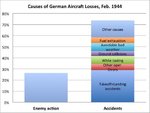Reegor
Airman 1st Class
I've just completed a paper on pilots' flight discipline and use of standard flying methods in multiple air forces in WW 2. The Luftwaffe was the worst by far. They even called their high accident rate "the plague." Simply transferring planes from factory to the front had a 20% loss rate!!
Some of my findings are likely to be controversial. The RAF, the Luftwaffe, and to an extent the US Navy had needlessly high losses
due to accidents. The Brits had access to all the American checklists but instead made up with their own weak versions. Curtis LeMay turns out to be one of the key leaders of the USAAF. I am hoping that people on this list will take a look and add material/make corrections.
The paper is at NOT FLYING BY THE BOOK: SLOW ADOPTION OF CHECKLISTS AND PROCEDURES IN WW2 AVIATION. It covers the following air forces:
Slow adoption during WW2 cost many lives. Worst affected was probably the German Luftwaffe, whose new pilots suffered accidents rates of about 100 percent per year, partly as a result of its antiquated flying paradigm. The British Royal Air Force and the US Navy were also slow to make full use of the new technology. Ironically, the US Navy published the first known formal checklist, in May 1937. I discuss why the ethos of Navy pilots and commanders, and the type of fighting it did during WW2, kept it from making the change to Standard Procedure Flying.
Thanks for any suggestions!
Some of my findings are likely to be controversial. The RAF, the Luftwaffe, and to an extent the US Navy had needlessly high losses
due to accidents. The Brits had access to all the American checklists but instead made up with their own weak versions. Curtis LeMay turns out to be one of the key leaders of the USAAF. I am hoping that people on this list will take a look and add material/make corrections.
The paper is at NOT FLYING BY THE BOOK: SLOW ADOPTION OF CHECKLISTS AND PROCEDURES IN WW2 AVIATION. It covers the following air forces:
- American Army Air Force ( AAF) fighter pilots
- American AAF strategic bombers, in both Europe (B-17s) and Asia(B-29s)
- American Naval aviation
- British Royal Air Force
- German Luftwaffe
- American Army helicopters in Vietnam (briefly)
Slow adoption during WW2 cost many lives. Worst affected was probably the German Luftwaffe, whose new pilots suffered accidents rates of about 100 percent per year, partly as a result of its antiquated flying paradigm. The British Royal Air Force and the US Navy were also slow to make full use of the new technology. Ironically, the US Navy published the first known formal checklist, in May 1937. I discuss why the ethos of Navy pilots and commanders, and the type of fighting it did during WW2, kept it from making the change to Standard Procedure Flying.
Thanks for any suggestions!

